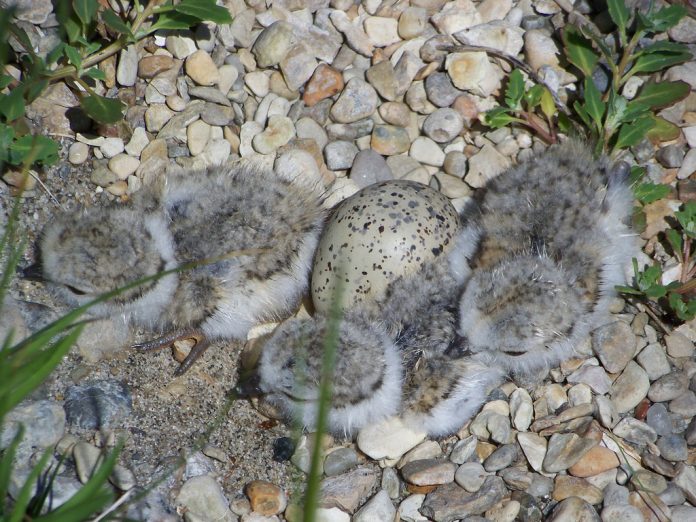
For the second consecutive year, a pair of federally endangered piping plovers are raising chicks on Gull Point at Pennsylvania’s Presque Isle State Park.
Adding to the excitement is news that a pair of state-endangered common terns also nested on the same beach. Unfortunately, the natural forces that helped create Gull Point — erosion, wind, and wave action — continually threaten its size and stability.
That’s why state and national conservation agencies banded together several years ago to manage sandy beaches for wildlife.
Game Commission Executive Director Bryan Burhans reported in a recent press release, “The investment we made to bring back piping plovers and common terns is starting to pay off.”
Plovers
Last summer two pairs of state-endangered piping plovers nested successfully on a beach in Presque Isle State Park. The first pair hatched three chicks and ultimately raised two, the first Pennsylvania-hatched plovers since the 1950s.
A second plover nest on the same beach had four eggs rescued when strong waves threatened to carry them into Lake Erie. Those eggs hatched two more chicks; they were released last August on Lake Superior after being raised at the University of Michigan Biological Station piping plover captive-rearing facility.
One of the rarest birds in the Great Lakes region, piping plovers (kin to killdeer) are slightly larger than a sparrow and found in three geographically separate populations: Atlantic Coast and Northern Great Plains (protected as threatened) and the Great Lakes (protected as endangered).
The world piping plover population numbers just over 4,000 pairs. This summer, they’re back. And we know it’s them because they’ve been identified by the leg bands placed on them last year.
Mary Birdsong, assistant director and lead shorebird monitor for Erie Bird Observatory, reported the nesting female plover was first observed May 3. The male was first seen April 21.
Common terns
Birdsong also discovered common terns nesting on the beach May 31.
“It’s extraordinary that both common terns and piping plovers have nested at Presque Isle this year,” said Dan Brauning, game commission wildlife diversity division chief. “This has not been documented recently in other Great Lakes states, or in Pennsylvania for decades.”
Common terns haven’t nested regularly in Pennsylvania since 1966. Their breeding populations have declined throughout both the Great Lakes and the Atlantic Coast. They are about twice the size of a piping plover.
After a territorial male piping plover was observed on Gull Point in 2005, Cathy Haffner, a game commission biologist who has studied piping plovers since 2001, recommended that woody and invasive vegetation be removed along the Gull Point Natural Area shoreline to improve plover nesting habitat.
Hard work
With time, patience, persistence and funding, anything is possible.
“After years of hard work through partnerships, coordination and resource management, we have now seen two successful nesting seasons for piping plovers at Presque Isle State Park,” said DCNR Secretary Cindy Adams Dunn.
The Great Lakes piping plover population bottomed out in the late 1980s when only 17 breeding pairs along Michigan’s shoreline were recorded. But steep declines in piping plover and common tern populations through the 1940s and ‘50s — accompanied by increasing interference from predation, development and human traffic on beaches — endangered the Great Lakes and coastal populations.
Piping plovers are highly vulnerable to disturbance during all phases of the nesting season. Consequently, the nests are in protected, restricted areas designated by signage and fences.
Upon their return to breeding grounds in April and May, male common terns and piping plovers set up and defend nesting territories. After the female lays her eggs in a sandy scrape, parents take turns incubating the eggs for about a month.
Shortly after hatching, plover chicks stay close to both parents and feed independently on small insects and invertebrates along shallow beach pools.
Common terns can walk after hatching, but they stay close to the nest and are fed by both parents. Until the chicks can fly, they stay safe by responding to vehicles, predators and hikers by “freezing” and crouching down in the sand to become almost invisible.












